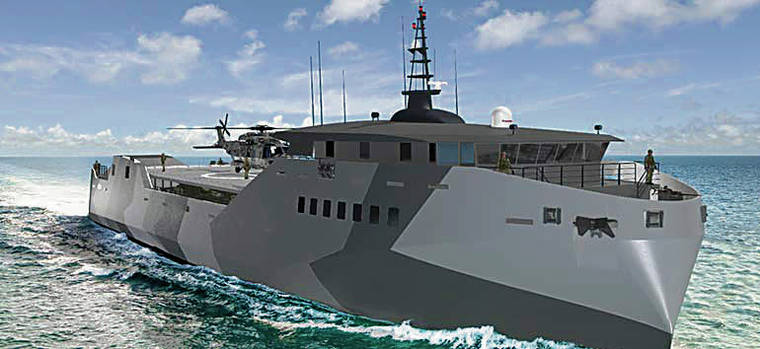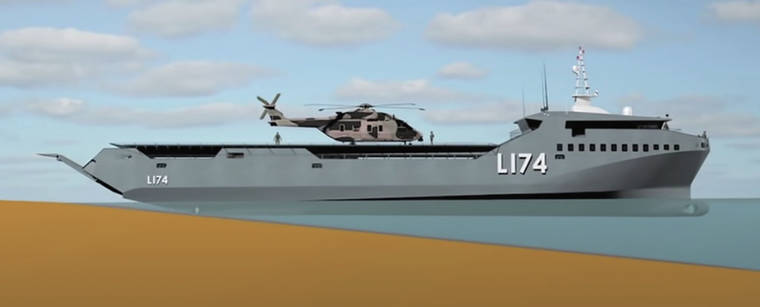Hawaii first to get new warships that can pull up onto beaches

COURTESY SEA TRANSPORT SOLUTIONS
A rendering of a possible stern-landing vessel for Marine Corps use.

COURTESY CONGRESSIONAL RESEARCH SERVICE
A stern-landing Marine Corps Light Amphibious Warship design envisioned by Sea Transport Solutions.


The Marine Corps later this year plans to activate in Hawaii its first-ever Marine Littoral Regiment — the centerpiece of a sweeping force redesign enabling troops to operate in small units with ship-killing missiles from the islands that dot the Western Pacific.
Part of that redesign calls for a new class of Navy vessel in Hawaii called the Light Amphibious Warship, which can pull up onto beaches, will be between 200 and 400 feet long and cost $100 million to $130 million, according to the Congressional Research Service and other sources.
By comparison, a new destroyer costs more than $1.5 billion. The Navy wants to have 28 to 30 of the smaller amphibious ships.
How many could be based in Hawaii remains unclear, as is where they would practice beach landings in the isles. In addition to Hawaii, the Marine Corps might have Marine Littoral Regiments in Guam and Japan as fast- moving counterweights to China’s growing navy fleet.
Light Amphibious Warships would have the ability to carry 40 Navy sailors and at least 75 Marines, 4,000 to 8,000 square feet of cargo area for equipment and supplies, and a minimum un-refueled transit range of 3,500 nautical miles, the Congressional Research Service said. “Littoral” refers to operations around the shore, where equipment and personnel can be shifted from water to ground and back.
Maj. Gen. Tracy King, director of expeditionary warfare on the chief of naval operations staff, said Jan. 8 that the Navy and Marine Corps are moving quickly to buy the first such warship in fiscal 2022, U.S. Naval Institute News reported.
Don't miss out on what's happening!
Stay in touch with breaking news, as it happens, conveniently in your email inbox. It's FREE!
More recently, Lt. Gen. Eric Smith, who heads Marine Corps Combat Development Command, said during a defense forum Feb. 10 that a variety of assets — including the new smaller vessels — will allow the Corps to rapidly distribute what amounts to reinforced- platoon-size elements of Marines.
“In the past you think, well, there’s 75 Marines in location ‘X.’ They’re not a threat,” Smith said. “If I can sink one of your $1.5 billion warships with a $1.5 million missile, I am a threat.”
If the Marines fire missiles from smaller vehicles and move rapidly “to make it incredibly hard for you to find me … you have to respect that very small unit — of which we will have dozens and dozens and dozens placed strategically throughout” a region, Smith said.
While started and focused on the Pacific, the “force we’re building is highly useful in the European theater,” he said. “Highly useful if we were to go into Africa, South America, any contingencies.”
Marine Corps Commandant Gen. David Berger, who used to command Marine Corps Forces Pacific on Oahu, said in his Commandant’s Planning Guidance that the United States’ ability to project power is increasingly challenged by long-range missiles.
Naval expeditionary forces need a variety of deployment options including not only big amphibious assault ships, but also unmanned platforms, stern landing vessels and oceangoing “connectors,” he said.
“We must continue to seek the affordable and plentiful at the expense of the exquisite and few when conceiving of the future amphibious portion of the fleet,” Berger said.
The Hawaii-based Marine Littoral Regiment will be drawn largely from the 3rd Marine Regiment at Kaneohe Bay, which has about 3,400 Marines.
Between 1,800 and 2,000 Marines will make up the new formation, which will be re-branded the 3rd Marine Littoral Regiment. As the exception, most of the batteries that make up a Littoral Anti-Air Battalion will come from units not stationed in Hawaii.
Maj. Joshua Benson, a spokesman for Marine Corps Combat Development Command, said the Hawaii Marines with the existing regiment who are not part of the new unit will rotate out as their orders change or they exit the Corps.
The 3rd Marine Littoral Regiment is expected to activate at the start of fiscal year 2022, which begins Oct. 1, with initial operating capability anticipated in 2023, officials said.
“Over the next few years, the specifics of the MLR will begin to take shape,” Benson said in an email. “Experiments, war games, modeling and simulation will play a key role in the phased approach to the MLR development.” First, the formation will be built, then the capabilities will be flowed in, he said.
Smith noted that in the Pacific, the Marines have two regiments on Okinawa and one in Hawaii. Eventually, one regiment will be on Okinawa, one in Hawaii and one on Guam, he said.
“So those three regiments already exist,” he said. “They simply do not exist in the best form to be very rapidly deployable.”
The new Hawaii unit is part of big changes the Marine Corps wants to make over the next decade as it reorganizes to deter war mainly with China, or win a war if it comes to that.
The naval expeditionary force wants to shrink its numbers by 12,000 (186,000 are in the Corps now) and specialize in the littorals. Berger has previously said the Marine Corps is built for past land wars and that “we must change.”
Divestiture of traditional capabilities would result in a potential savings of $12 billion — to be reallocated toward emerging threats. The Corps already is removing tanks from its arsenal.
Tanks are “tremendous assets,” Smith said. But “we can kill armor formations at further ranges” using mobile missiles without incurring a “74-ton challenge trying to get that (tank) to shore.”
The Corps is testing missiles fired from a joint light tactical vehicle that have 15 to 20 times the range within a U.S. tank can take out another main battle tank, he said.
The Navy is working its way from 10 or 11 industry groups down to one to start building the first Light Amphibious Warship in late fiscal 2022, USNI News reported.
“We’re just going to build one, get that out and start playing with it,” King, director of expeditionary warfare, said during a Jan. 8 media call. “We’ll probably build one the next year because we’ve got to get the doctrine right. The (Marine Littoral Regiments) are going to start coming online at about the same time. First one’s in Hawaii; we’ll get it out there and let them play with it. And then we’ll go into a build profile of, I don’t know, probably four or five a year.”
Benson, the Marine Corps Combat Development spokesman, said the goal — even before initial operating capability is met — is to get the Marine Littoral Regiment involved in force design experiments. “The feedback is absolutely critical to ensure we get this right,” he said.



